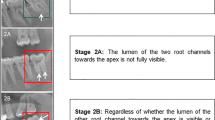Abstract
The question of whether an individual has reached the age of 18 is of crucial importance in forensic age estimation practice. In some countries, the age threshold of 21 years is relevant as well. A completed mineralization of third molars is not a sufficient criterion for a diagnosis of a minimum age of 18 years with the required probability. In a material of 1,198 orthopantomograms from 629 females and 569 males aged between 15 and 40 years, the visibility of the root pulp of fully mineralized lower third molars was evaluated according to stages 0, 1, 2, and 3. In females, stage 0 was first noticed at age 17.2 years, in males at age 17.6 years. In either sex, the earliest observation of stage 1 was between 21.0 and 22.4 years. Stage 2 was first achieved by males between 22.3 and 22.7 years, by females between 23.4 and 24.7 years. The occurrence of stage 3 was first found in both sexes between 25.1 and 25.9 years. These findings indicate that for stage 0, an age below 18 years cannot be excluded. However, for stage 1, the examined individual must be over 18 years of age and most probably over 21 years of age. For stages 2 and 3, the age can safely be stated to be over 21 years of age. This method may be a powerful tool for forensic dentists in age estimation in asylum and criminal proceedings.

Similar content being viewed by others
References
Schmeling A, Grundmann C, Fuhrmann A, Kaatsch H-J, Knell B, Ramsthaler F, Reisinger W, Riepert T, Ritz-Timme S, Rösing FW, Rötzscher K, Geserick G (2008) Criteria for age estimation in living individuals. Int J Legal Med 122:457–460
Kahl B, Schwarze CW (1988) Aktualisierung der Dentitionstabelle von I Schour und M Massler von 1941. Fortschr Kieferorthop 49:432–443
Mincer HH, Harris EF, Berryman HE (1993) The A.B.F.O. study of third molar development and its use as an estimator of chronological age. J Forensic Sci 38:379–390
Olze A, Schmeling A, Rieger K, Kalb G, Geserick G (2003) Untersuchungen zum zeitlichen Verlauf der Weisheitszahnmineralisation bei einer deutschen Population. Rechtsmedizin 13:5–10
Knell B, Ruhstaller P, Prieels F, Schmeling A (2009) Dental age diagnostics by means of radiographical evaluation of the growth stages of lower wisdom teeth. Int J Legal Med 123:465–469
Gunst K, Mesotten K, Carbonez A, Willems G (2003) Third molar root development in relation to chronological age: a large sample sized retrospective study. Forensic Sci Int 136:52–57
Kvaal SI, Kollveit KM, Thomsen IO, Solheim T (1995) Age estimation of adults from dental radiographs. Forensic Sci Int 74:175–185
Landa MI, Garamendi PM, Botella MC, Alemán I (2009) Application of the method of Kvaal et al. to digital orthopantomograms. Int J Legal Med 123:123–128
Solheim T (1995) En ny metode for å beregne alderen hos voksne basert på ikke-ekstraherte tenner. In: Olaisen B, Teige B (eds) XII Nordiske Møte i Rettsmedisin: Kongressrapport. University of Oslo, Oslo, pp 72–76
Schmeling A, Baumann U, Schmidt S, Wernecke KD, Reisinger W (2006) Reference data for the Thiemann–Nitz method of assessing skeletal age for the purpose of forensic age estimation. Int J Legal Med 120:1–4
Schmeling A, Schulz R, Reisinger W, Mühler M, Wernecke K-D, Geserick G (2004) Studies on the time frame for ossification of medial clavicular epiphyseal cartilage in conventional radiography. Int J Legal Med 118:5–8
Schulz R, Mühler M, Reisinger W, Schmidt S, Schmeling A (2008) Radiographic staging of ossification of the medial clavicular epiphysis. Int J Legal Med 122:55–58
Kellinghaus M, Schulz R, Vieth V, Schmidt S, Schmeling A (2009) Forensic age estimation in living subjects based on the ossification status of the medial clavicular epiphysis as revealed by thin-slice multidetector computed tomography. Int J Legal Med. doi:10.1007/s00414-009-0398-8
Solheim T (1992) Amount of secondary dentin as an indicator of age. Scand J Dent Res 100:193–199
Author information
Authors and Affiliations
Corresponding author
Rights and permissions
About this article
Cite this article
Olze, A., Solheim, T., Schulz, R. et al. Evaluation of the radiographic visibility of the root pulp in the lower third molars for the purpose of forensic age estimation in living individuals. Int J Legal Med 124, 183–186 (2010). https://doi.org/10.1007/s00414-009-0415-y
Received:
Accepted:
Published:
Issue Date:
DOI: https://doi.org/10.1007/s00414-009-0415-y




